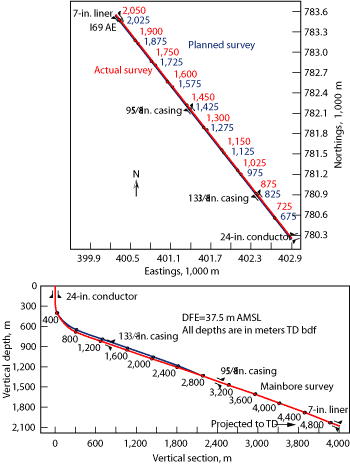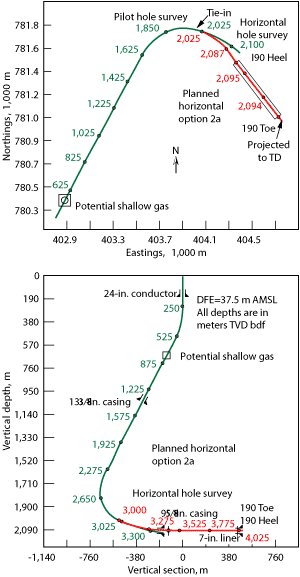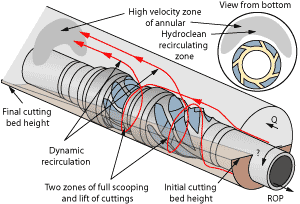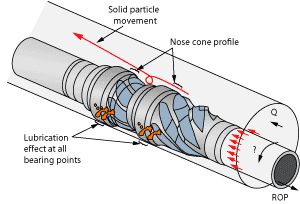Proper hole cleaning reduced torque and drag from cuttings dunes, while helping prevent stuck pipe, lost circulation and hole instability.
Hapiztuddin Mangor, Talisman Energy; Raymond Elder, Certified Oilfield Rentals; Jean Boulet and Anthony Monnet, VAM Drilling
Talisman has established new drilling practices using an optimized hole-cleaning management process that has enhanced hole-cleaning performance. This article explains how drilling parameters were managed to improve and optimize drilling performance on development wells in Bunga-Kekwa Field in Malaysia, Fig. 1.
 |
|
Fig. 1. Bunga Kekwa-Raya Fields are in Block PM-3 CAA offshore eastern Malaysia.
|
|
The technical challenges to drilling high-angle wells are many. The objective is to achieve operational efficiency within the required safety margins and at identifiable cost savings. When drilling highly deviated and complex wells, this means optimizing operational parameters and procedures for efficient hole-cleaning and frictional-load control.
Hole cleaning is one of the main issues when drilling deviated wells, whether in cased or open hole. Well sections with inclinations above 40° have been identified in the lab and confirmed in the field to be the zones with cuttings sedimentation and recirculation problems. In these wells, hole cleaning is often perceived as a straightforward process, but quantifying cuttings retrieval rates and determining the residual bed height downhole should be a management process involving two challenges: decaying and recirculating cuttings, and transporting solid particles to the surface.
These challenges are further linked with the compatibility between operating parameters, wellbore quality, wellbore stability, safety margins and cost-efficiency of the operation.
By optimizing hydraulics, mechanical parameters and drillstring construction, it is possible to increase performance of: drilling, operating cost, safety margins and drilling risk prevention from stuck pipe, lost circulation and hole instability.
HOLE CLEANING PRINCIPLES
How do we determine when a hole is clean? The usual approach is to monitor the shakers for changes in the cuttings retrieval rate. Although this is a direct indicator, it does not provide complete information and can lead to incorrect assumptions and detrimental misunderstandings. The quantity of retrieved solid particles may not represent the actual volumes that should be retrieved due to irregularities in the hole section. Even if the cuttings volume remaining in the hole looks acceptable, the distribution of cuttings along the hole can have a significant impact on drilling efficiency. An irregular distribution profile can induce avalanching, packoff, pressure surges and wellbore instability.
Hence the importance of defining successful hole cleaning by using a more complex monitoring system and taking into account risk-occurrence analysis. Monitoring systems should capture the cuttings retrieval rate, Equivalent Circulating Density (ECD), pressure losses and torque and drag curves. Risk occurrence analysis should include pressure surges, back reaming, hole packoff, casing/equipment wear and stuck pipe.
Hole cleaning and drilling practices. Hole cleaning problems start when operating parameters fail to efficiently circulate cuttings to surface. Problems have been identified in the drilling and tripping phases.
Drilling and tripping represent two different modes of cuttings bed buildup processes and hole-cleaning practices. During drilling, there is an equilibrium cuttings-bed height that can be used for hole-cleaning efficiency by measuring the cuttings at surface versus the calculated cuttings volume expected to be generated when drilling a formation. Even though the bed reaches a steady state (provided parameters remain unchanged), the cuttings-bed height is not necessarily regularly distributed along the drillstring. For this mode, hole-cleaning performance corresponds directly to the final equilibrium bed height.
During tripping, cuttings can build up under several conditions. Natural sedimentation of solid particles occurs when mud flow stops. Dragging the drillstring through the existing cuttings bed creates localized “dunes.” Cuttings’ avalanching occurs when the bed is established in the critical angle (45-60°) section of the well. For this mode, hole-cleaning performance is related to the speed at which the system decays the cuttings and to the final cuttings-bed height.
Operating parameters analysis. Flowrate is the main component of hole cleaning. In most cases, required flowrates will not be achievable due to the available rig capability. Further flowrate limitations are restricted by maximum ECD values on the formation. In addition, high flowrates can generate hole enlargement or caving. Increasing the flowrate to improve hole cleaning can be done within limitations, but care must be taken to avoid worsening the situation.
Rotational speed (rpm) is the second most well-known, and sometimes misunderstood, hole-cleaning component. Although increasing pipe rotation improves cuttings agitation, drillstring rotational speed has a limited effect on cuttings recirculation and cannot achieve a completely clean hole.
The primary advantage of increased rpm is cuttings agitation, which limits cuttings sedimentation. The lifting effect is created by the upward driving effect of mud-flowing lines on the solid particles. Therefore, rpm efficiency is related more to cuttings agitation than cuttings recirculation.
Increasing rotational speed increases the risk of drillstring fatigue and dynamic vibration. It also increases the risk of wellbore damage and caving. In addition, it has been shown that high rpm will increase ECD values, mainly due to drillstring behavior at high rotation speed in conjunction with mud-flowing line disturbances. Increasing the rotational speed to improve hole cleaning is applicable for low-complex wells and is of limited efficiency. However, field experience has proven that string rotation above 120 rpm avoids excessive cuttings sedimentation, thanks to particle agitation by the drillstring.
Mud rheology plays a significant role on cuttings suspension in the flow. The lubricity of the mud is the main factor that helps suspend cuttings. Mud rheology is not an optimization parameter, since it will not be variable. Mud properties are adapted to the formation and well profile.
FIELD APPLICATION
Talisman Malaysia Ltd. (TML) operates Block PM-3 CAA offshore eastern Malaysia, which is about 240 km northeast of Kertih, Terengganu. To date, six wellhead platforms have been installed to develop the Bunga Kekwa-Raya Fields.
The first development was in 2002 with the installation of Bunga Kekwa-A (BK-A) platform with 10 wells. Subsequent field development plans installed Bunga Kekwa-C (BK-C), Bunga Raya-B, Bunga Raya-C and Bunga Seroja-A wellhead platforms to drill more wells of various utilities. Development drilling was carried out using the contracted jackup drilling rigs Harvey H. Ward and Roger W. Mowell. Both rigs are identical in size and equipment capability. To date, TML has drilled more than 100 km of 12¼-in. hole in over 60 development wells.
Reservoir targets in PM-3 area are of Middle Miocene and Lower Miocene age with reservoir depths ranging from 1,600-m TVD to 3,000-m TVD. The stratigraphy of the Malay Basin consists of a monotonous section of shales, sands and coals, nearly all deposited in coastal plain to shallow marine environments. Wells drilled in the PM-3 area encountered normal or near-normal pressure regimes with normal temperature gradient.
TML realized the importance of effective hole cleaning to mitigate stuck-pipe incidents. The majority of BK-A wells encountered frequent hole problems in the 12¼-in. hole section associated with borehole cleaning. In 12¼-in. holes, common values of flowrate, combined with mud properties and drillstring rpm, usually maintain laminar or transitional mud flow. However, in areas with cuttings dunes, at flowrates above 1,000 gpm and 110 rpm, the flow can become turbulent and significantly increases pressure losses.
Typical well profiles include build-and-hold and hold-and-drop (S profile) with inclinations up to 70° and openhole sections ranging from 1,000 m to 2,500 m. These wells were drilled with synthetic-based mud and a steerable assembly using standard 5-in. drill pipe and 8-in. drill collar in the BHA. Often, the trip out from TD was difficult due to numerous tight spots, most likely caused by cuttings beds.
Example 1. Well A was drilled prior to implementing the new hole-cleaning approach. This particular well with TD of 11,254-ft MD has 5,250 ft of 12¼-in. hole section with maximum inclination of 56°, Fig. 2. The BHA included PDC bit, mud motor, MWD/LWD, drill collar and 5-in. drill pipe.
 |
|
Fig. 2. Well A was drilled before the new hole cleaning approach and has 5,250 ft of 12¼-in. hole section with 56° maximum inclination.
|
|
Considerable sliding difficulties were noticed beginning at around 1,312 ft, before reaching TD. Tripping out was not smooth, with numerous tight spots. The tight spots were worked through after wiping. Subsequently, electric logging was run on wireline, but was held up at 5,958-ft MD. The logging tool was then run on drill pipe, but was only able to go to 6,339 ft. A wiper trip assembly was run and the logging run was repeated on drill pipe, but the logging tool was held up at 6,690 ft, after which the operation was aborted. The 95/8-in. casing was run, but it was held up at 6,959 ft and attempts at working and washing the casing through this depth were unsuccessful. The casing was pulled out and a wiper trip was run. All the tight spots encountered were reamed through. The casing was re-run and had to be worked and pushed with the top drive, and washed down before it was landed at the planned depth.
TML started using hole cleaning management in 2003. The optimization procedure enabled them to define efficient operational parameters and drilling procedures to improve hole cleaning. After analyzing well objectives for the BK-C development program and following the experience of BK-A wells, the company set standard parameters with drilling and general guidelines:
- Flowrate: The goal is to maximize flowrates at all times, taking into account ECD control limitations. Typical flowrate is from 950 to 1,050 gpm.
- String rotation: Maximize rpm at all times using cuttings agitation to avoid solid particle sedimentation. Typical range is 90-120 rpm, depending on motor bend and WOB. In most cases, rotation is maintained above 120 rpm.
- Mud rheology: Maintain plastic viscosity and low-gravity solids as low as possible and minimize mud weight. Mud weight is normally maintained at a minimum of 10.2 ppg for borehole stability. Depending on hole angle and condition, mud weight may be raised to 11.0 ppg.
- ROP: Optimize the rate of penetration based on torque and drag readings and other system limitations. The use of PDC bits resulted in higher ROP. However, in most cases, ROP is limited to 50-60 m/hr for LWD data acquisition.
Hole cleaning performance was monitored based on:
- Cuttings: Monitor cuttings regularly gauging their volume, size and shape to indicate hole cleaning effectiveness.
- Torque and drag: Ensure that pick up, slackoff, rotating-off-bottom weight and torque data are recorded in a consistent manner after each stand. This is interpreted real-time on the rig floor for immediate action. If a tight spot is encountered (>30 kips overpull) while tripping out of hole, assume the tight spot is from cuttings. Run-in-hole two stands, until the BHA is clear of the obstruction. Circulate and rotate for 30 min. or longer to confirm that the tight spot is caused by a cuttings bed.
- Weighted pills: Regularly pump 14-ppg pills as the hole dictates to sweep cuttings beds. Record sweep effectiveness in the drilling reports. If a large amount of cuttings are seen on the shaker, then increase pill frequency and/or reduce ROP, so as not to overload the annulus.
When hole cleaning became a problem while drilling, the following steps were taken to alleviate the difficulties. Drilling parameters were verified and changed, if necessary. ROP was controlled until actual torque and drag measurement returned to theoretical values/curves. Procedures were used to stop drilling, pull off bottom and perform a clean-up cycle. Other alternatives were considered such as sweeps, back-reaming or wiper trips. If excessive cuttings dunes appeared, cuttings transport wasreviewed, since the cuttings quantity remaining downhole was irregular. In such situations, the spacing of cleaning joints in the string is needed to ensure a “cuttings conveyor belt” effect.
It became clear that improper hole cleaning was very costly. As a result of lessons learned from these wells, TML implemented a new hole-cleaning management procedure and started using the new hole cleaning approach on BK-C wells.
Example 2. Well B has about 1,700 m of 12¼-in. hole section with maximum inclination of 73°, Fig. 3. Due to higher inclination, the operator’s main concern was hole-cleaning effectiveness. The standard BHA design included a PDC bit, MWD/LWD and 65/8-in. Hydroclean HeavyWeight (HHW) drill pipe to further assist cuttings removal.
 |
|
Fig. 3. Well B has 1,700 m of 12¼-in. hole section with 73°maximum inclination.
|
|
As another part of this improvement, the 5-in. drill pipe was replaced with 5½-in. drill pipe, including cleaning tools, to provide better hydraulics. Flowrates were maintained at 1,000 gpm (3,700 psi SPP) while drilling this section. The use of drill collars was discontinued and replaced with 65/8-in. HHW cleaning tools and drill pipe.
No hole cleaning problems (e.g., hole packoffs) were encountered while drilling the hole section. Directional control was excellent and no difficulties were experienced while sliding, with good steerability all the way to TD. Torque and drag remained below the predicted readings throughout drilling. A few tight spots with overpull of more than 30 kips were encountered while tripping out, indicating that the hole still had some cuttings beds. These situations were worked through according to standard hole-cleaning procedures. Tripping in hole with 95/8-in. casing to bottom was slick with no excessive drag.
Example 3. Well C, a horizontal well, had 2,010 m of 12¼-in. pilot hole section with maximum inclination of 80° at section TD, Fig. 4. The pilot hole was plugged back and kicked off at 2,989 m and drilled to the 9 5/8-in. casing point at 3,408 m.
 |
|
Fig. 4. Well C had 2,010 m of 12¼-in. pilot hole with 80° maximum inclination.
|
|
The BHA used to drill this section included a PDC bit, 9 5/8-in. mud motor, 6 5/8-in. HHW drill pipe and 5½-in. drill pipe. Cleaning drill pipe (5½-in. OD) was spaced out every three stands to improve cuttings movement. A shock absorber and an agitator were also used to further enhance BHA characteristics.
The ROP was controlled at 60 m/hr from the start of drilling to not overload the annulus with cuttings. Torque and drag remained at acceptable values while drilling this section and no excessive drags were experienced. No tight spots or packoffs were encountered while drilling the pilot and sidetrack hole. Average flowrates of 950 gpm were achieved with 3,500 psi SPP, indicating that the hole was relatively clean. At TD, the BHA was pulled out with no problems; only one tight spot was encountered in the pilot hole and a few in the sidetrack hole, which were worked through. The 95/8-in. casing was run to landing in the horizontal hole with no problem.
The cleaning-tool pipe has been effective in reducing cuttings bed accumulation. Problems associated with hole cleaning and problems in sliding were reduced. Tripping time after reaching TD was also reduced from 12 to 20% of drilling time, depending on hole angle, with fewer tight spots encountered.
COST ANALYSIS
Field experience has confirmed the benefits of using cleaning tools with improvements at all levels. A detailed time analysis of PM-3 BK-C wells has shown significant reduction of non-productive time, when drilling the critical sections. The main time savings were identified at two levels: tripping and cleaning. Tripping time (in and out) is reduced due to reduced pickup weights and less drag, a consequence of better hole cleaning. The number of wiper trips was reduced (or eliminated).
Cost savings were calculated for the critical 12¼-in. sections from the well report’s time analysis for the BK-C wells program. For a rig spread rate of $250,000/day, savings during tripping were six hours or $9,000/day, while savings from wiper trips equaled three hours or $5,000/day. Considering an average seven drilling days for this section, the potential savings are up to $100,000. This study did not estimate indirect cost savings, such as reduced equipment wear.
CONCLUSIONS
Most of the industry has identified hole cleaning problems while drilling deviated (+40°) and extended-reach wells. The main operational benefits from this new hole-cleaning approach were measured directly while drilling: minimized backreaming operations, no stuck pipe or hole enlarging risks.
Using the new, mechanical hole-cleaning system, TML achieved enhanced hole cleaning at selected levels of flowrate and rpm values, allowing optimized levels of ROP and pressure losses. Field performance analysis showed torque and drag reduction due to enhanced frictional properties of the HBZs. Better hole cleaning reduced the remaining cuttings-bed height and decreased cuttings accumulation risks.
Prior to drilling highly deviated or complex wells, the hole cleaning system must be accurately pre-determined to ensure that all aspects of cuttings transport are reviewed. The full involvement of the drilling team, when implementing the cleaning system, enabled TML to reduce non-productive time and optimize hole cleaning management, which ensured efficient hole cleaning in the drilling and tripping phases.
Based on over 400 applications spread across the North Sea, Gulf Coast, Middle East and Far East regions, drilling engineers and crews have observed that cuttings appear at surface in a reduced amount of bottoms up. Cuttings volume over the shakers increased 14% or more. ECD, torque and drag were reduced because of a cleaner hole. The number of wiper trips to clean the hole and the amount of back-reaming were also reduced. 
ACKNOWLEDGEMENT
The authors thank Talisman Malaysia for permission to publish this paper. We also thank our colleagues for their assistance and especially R. D. Miller, TML drilling manager, and his team for their input. This article was derived from a paper presented at the IADC World Drilling Conference in Paris, France, June 13-14, 2007.
BIBLIOGRAPHY
Musaeus, N., “Ringhorne development: Technologies applied in extended reach drilling - successes, failures and communicating risks,” IADC/SPE 99124, presented at IADC/SPE Drilling Conference in Miami, Florida, US, February 21-23, 2006.
Reinhardt, W. R.; R. N. Williamson, L. F. Eaton and S. C. Actis, “Magnolia deepwater development-Striving for best-in-class drilling performance,” SPE 92439, presented at IADC/SPE Drilling Conference in Amsterdam, The Netherlands, February 23-25, 2005.
Wilson S. M., S. T. Edwards, A. Crook, A. Bere, D. Moos, P. Peska and N. Last, “Assuring stability in extended reach wells-analyses, practices and mitigations,” SPE/IADC 105405, presented at IADC/SPE Drilling Conference in Amsterdam, The Netherlands, February 20-22, 2007.
Green, M. D., Thomesen, C. R., Wolfson, L., and Bern, P. A., “An integrated solution of extended-reach drilling problems in the Niakuk Field, Alaska: Part 2-hydraulics, cuttings transport and PWD,” SPE 56564, presented at SPE Annual Technical Conference and Exhibition in Houston, TX, US, October 3-6, 1999.
Iyoho, A. W., R. A. Meize, K. K. Millheim and M. J. Crumrine “Lessons from integrated analysis of GOM drilling performance,” SPE 97464, presented at Offshore Technology Conference in Houston, TX, US, May 3-6, 2004.
Cameron, C., “Drilling fluids design and management for extended reach drilling,” IADC/SPE 72290, presented at IADC/SPE Middle East Drilling Technology Conference in Bahrain, October 22-24, 2001.
Foster, B., “Roadmaps improve extended reach well performance and decision making,” World Oil, June 2004.
Ward, C. and E. Andreassen, “Pressure-while-drilling data improve reservoir drilling performance,” SPE 37588, presented at IADC/SPE Drilling Conference in Amsterdam, The Netherlands, March 4-6, 1999.
|
HOLE CLEANING MANAGEMENT
Even with a fully optimized system, it may still be impossible to clean the hole sufficiently to achieve the desired drilling performance. In such cases, it is necessary to employ a mechanical boost to the system. Through careful planning of the spacing of cleaning joints in the drillstring, it is possible to significantly improve the cuttings transport.
The tool upset consists of two distinct zones: the Hydro-Cleaning Zone (HCZ) and the Hydro-Bearing Zone (HBZ). When combined with flowrate and pipe rotational speed, the bladed upsets improve hole cleaning in the drilling and tripping phase. The negative angle of the blades provides optimum scooping, while the variable helix angle accelerates the lifted particles and recirculates them into the hole’s maximum fluid velocity zone, Fig. A.
 |
|
Fig. A. Negative blade angles provide optimum scooping.
|
|
The profile’s HBZ protects the wellbore from the blades and provides optimized sliding properties, due to the hardbanding’s low friction profile. The conical design decreases friction from a fluid bearing effect between the pipe and wellbore, Fig. B.
 |
|
Fig. B. The conical design decreases friction.
|
|
The system’s transportation effect is ensured by creating a “cuttings conveyor belt.” The cleaning joints are integrated into the drillstring to place the tools in the hole’s critical sections. Joint placement is important for good system performance. General recommendations vary from one joint every two stands to one joint every three stands, based on field experience. Confirmation of the optimum spacing is one output of the optimization chart process.
In addition to the hole cleaning performance, the profiles reduce torque and drag, improve drillstring sliding behavior; improve weight-on-bit transmission and wellbore protection, while preventing stuck pipe and casing and equipment wear.
|
|
THE AUTHORS
|
|
|
Hapiztuddin Mangor earned a BS honors degree in mining and petroleum engineering from the University of Strathclyde in Glasgow, United Kingdom. He started his career as a drilling engineer with Esso Production Malaysia, where he was involved in ERD well planning. He later worked with other major operators around the Asian region and in the Middle East. Mangor is now the senior engineer with Talisman Energy for the BK-C Annex drilling campaign.
|
|
| |
Raymond Elder has 13 years of sales engineer experience with Omsco Industries, Drilltech Services and Offshore Rentals. Elder moved to Certified Oilfield Rentals in 2005 and is presently the company’s regional manager for the Far East.
|
|
| |
Jean Boulet earned a BS degree in engineering from the National School of Arts et Métiers in France and did post-graduate work at the French National School of Oil & Gas Engineers. He has over 30 years of industry experience and began his career as a Schlumberger drilling engineer. Boulet is presently R&D manager for VAM Drilling charged with designing drilling products and solutions.
|
|
| |
Anthony Monnet earned a BS degree in engineering from the National School of Arts et Métiers in France. He started his career as a technical sales engineer with SMF International, where he was involved in the development of new drilling products. Monnet is now a marketing and technical support manager with VAM Drilling involved in the development and support of high-performance drilling solutions.
|
|
|









